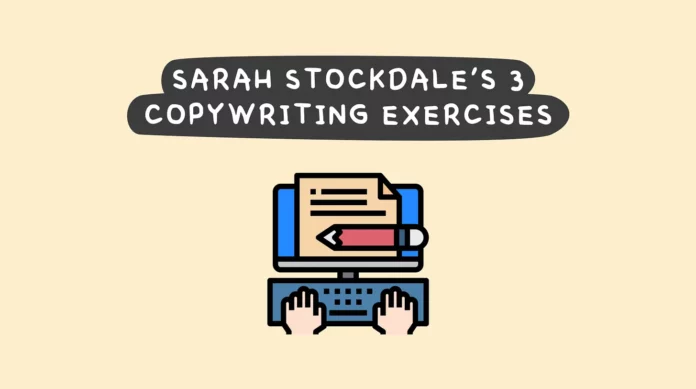In the everevolving world of digital marketing, crafting compelling copy that not only captures the audience’s attention but also converts them into paying customers is an essential skill. Whether you’re an experienced copywriter looking to refine your skills or a business owner eager to improve your product descriptions and ad campaigns, these three copywriting exercises will help you write copy that sells. These exercises are designed to enhance your creativity, persuasion, and understanding of your target audience.
Walk in Your Customer’s Shoes
To write copy that truly resonates with your audience, you need to understand their needs, desires, and pain points. Start by creating a detailed customer persona, including demographic information, interests, and challenges. Once you have a clear picture of your ideal customer, step into their shoes and view your product or service from their perspective.
Write a Day in the Life
Imagine a day in the life of your ideal customer. What challenges do they face? What goals are they trying to achieve? Write a narrative that captures their experiences, emotions, and frustrations. Use this exercise to identify the key pain points your copy should address and the benefits it should emphasize.
For example, if you’re selling a fitness app, create a story about a busy professional trying to stay healthy and fit amid a hectic work schedule. Highlight the app’s features that help them overcome obstacles and achieve their fitness goals.
The Power of Persuasion: AIDA
The AIDA model is a classic marketing and copywriting framework that stands for Attention, Interest, Desire, and Action. It outlines the stages a potential customer goes through when engaging with your copy. Crafting content that guides your audience through these stages is crucial for effective copywriting.
Write an AIDA Script
Choose a product or service you want to promote and create a script following the AIDA model:
Attention: Start with a compelling headline or hook that grabs the reader’s attention.
Interest: Develop a narrative that piques their interest by highlighting the product’s unique features or benefits.
Desire: Build desire by explaining how the product or service fulfills their needs or solves their problems.
Action: End with a strong call to action (CTA) that encourages the reader to take the desired action, whether it’s making a purchase, signing up for a newsletter, or requesting more information.
For example, if you’re writing a product description for a skincare product, your AIDA script might focus on the product’s ability to transform the user’s skin, building desire by emphasizing its natural ingredients and scientific backing.
The Art of Storytelling
Storytelling is a powerful tool in copywriting. It allows you to connect with your audience on a personal level, making your brand more relatable and memorable. People remember stories much better than they do dry facts and statistics.
Craft a Brand Story
Develop a compelling brand story that communicates your company’s values, mission, and unique selling proposition. Consider how your brand can resonate with your target audience emotionally. Use storytelling elements like characters, conflict, and resolution to create a memorable narrative.
For instance, if you run an ecofriendly clothing brand, your brand story might revolve around the journey of a passionate environmentalist who starts the brand to combat the fashion industry’s negative impact on the planet. This narrative can be woven into your website’s “About Us” page, creating a strong emotional connection with environmentally conscious consumers.
Optimizing Your Copy for SEO
While these exercises focus on improving your copywriting skills, it’s essential to keep SEO in mind to ensure your content gets discovered online. To enhance your SEO efforts, use relevant keywords strategically throughout your copy. For instance, if you’re writing about digital marketing services, incorporate keywords like “digital marketing strategies,” “SEO services,” or “content marketing.”
Additionally, use LSI (Latent Semantic Indexing) keywords to improve the context and relevance of your content. These are keywords related to your main topic that help search engines understand the content’s theme better.
Internal Linking for Enhanced User Experience
To further enhance the user experience and keep your audience engaged, consider incorporating internal linking within your copy. Internal linking refers to the practice of linking to other relevant pages on your website. This not only keeps readers on your site longer but also helps search engines understand the hierarchy and structure of your content.
For instance, if you’ve mentioned the benefits of your product in your copy, you can include a link to a dedicated “Benefits” page that provides more in depth information. Similarly, if your copy discusses how your service works, linking to a “How it Works” page can provide additional details, keeping readers informed and engaged.
Internal linking also improves your website’s SEO, as it allows search engines to crawl and index your pages more effectively. Just be sure that the linked pages are genuinely relevant to the content and add value to the reader.
Monitoring and Iterating
After implementing these copywriting exercises and optimizing your content for SEO, it’s crucial to monitor the performance of your copy. Track metrics such as clickthrough rates (CTR), conversion rates, and bounce rates to gauge the effectiveness of your copywriting efforts.
Tools like Google Analytics and Google Search Console can provide valuable insights into how your content is performing. Use these insights to make datadriven decisions and iterate on your copywriting strategies. If you find that certain pages are not performing as expected, consider revising the copy, improving the call to action, or adjusting your SEO strategy.
Regularly reviewing and updating your content is essential, as it ensures that your copy remains relevant and competitive in the everchanging digital landscape.
Incorporating Feedback
Another valuable practice is to seek feedback from peers, colleagues, or even customers. Fresh eyes can provide valuable perspectives and identify areas for improvement in your copy. Constructive feedback can help you refine your messaging, eliminate ambiguities, and address any potential pain points your audience may have.
Consider conducting A/B tests to compare different versions of your copy to determine which one resonates best with your audience. Test variations of headlines, calls to action, or product descriptions to see which performs better in terms of conversions and engagement.
Final Thoughts
Mastering the art of copywriting is an ongoing process that requires dedication and continuous improvement. By incorporating the three copywriting exercises outlined in this article—empathizing with your customers, applying the AIDA model, and harnessing the power of storytelling—you can create compelling, persuasive copy that drives sales and engages your audience.
Remember to optimize your copy for SEO by strategically using keywords and LSI keywords to improve visibility and reach. Additionally, enhance the user experience by incorporating internal linking to relevant pages within your website.
With a commitment to refining your copywriting skills, monitoring performance, and incorporating feedback, you can stay ahead in the competitive world of digital marketing and ensure your content consistently delivers results. Effective copywriting is not just about words; it’s about creating a connection with your audience and driving them to take action, ultimately contributing to the success of your business.







